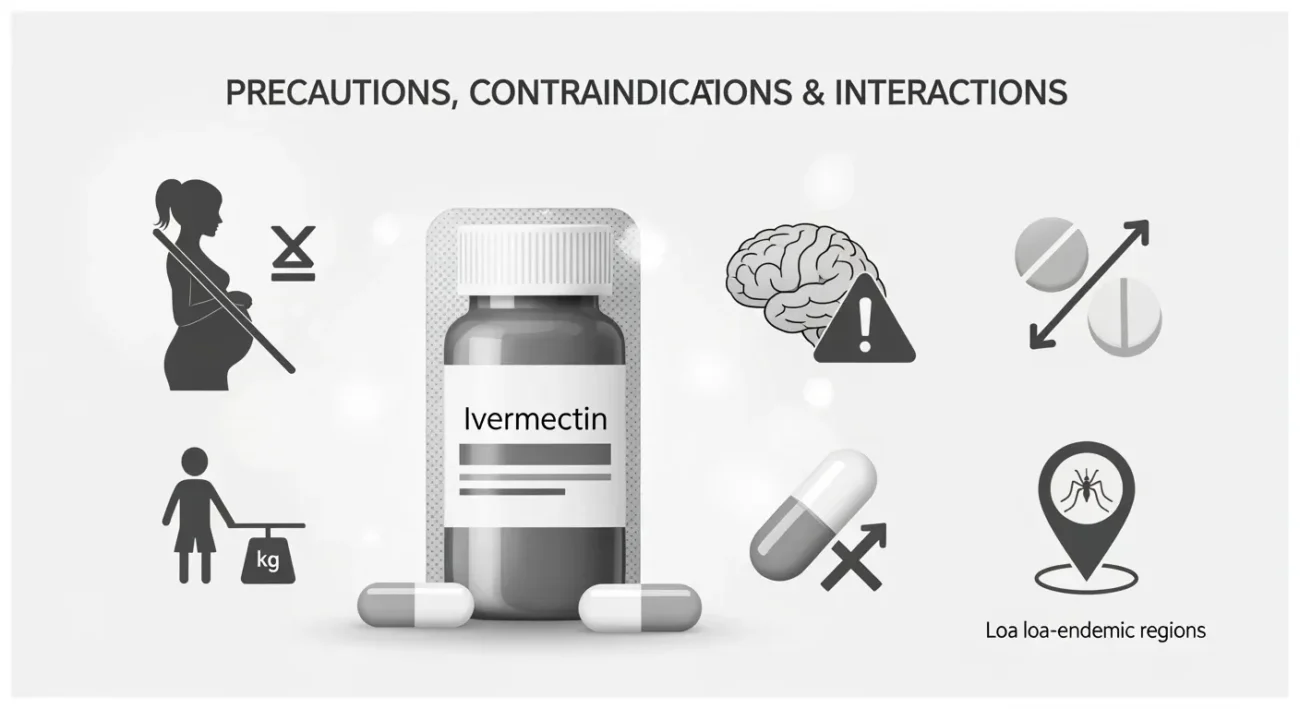Have you ever heard of ivermectin and wondered what it’s really for, how much you should take, and what risks are involved, You’re not alone ivermectin has made headlines (sometimes controversially), but much of the public discussion is confusing or incomplete.
What Is Ivermectin and How Does It Work?
Ivermectin is a medication that belongs to a class called anthelmintics (anti-worm drugs). It was originally developed for parasitic infections, especially in tropical and low-resource settings. In humans, it’s used to treat certain worm infections, mites, and lice.
Ivermectin disrupts the nerve and muscle function of many parasites. More technically, it binds to channels (glutamate-gated chloride channels) in parasite nerve/muscle cells, increasing chloride influx, causing hyperpolarization, and paralyzing them. The parasite can’t survive or reproduce. Mammals (humans) are less affected because these channels are less accessible in us, and the drug does not easily cross the blood-brain barrier at normal doses.
Because of its effectiveness and safety margin (when used properly), ivermectin has earned a reputation as a “wonder drug” in parasitic disease control efforts worldwide.
Approved Human Uses
Here are some of the main human uses of ivermectin (this list is not exhaustive):
- Strongyloidiasis (an intestinal worm infection)
- Onchocerciasis (“river blindness”)
- Scabies (mite infestation) often in places where topical treatments are hard to use
- Lice (head lice, pubic lice) in some formulations or off-label use
- Rosacea (topical ivermectin cream) when caused or exacerbated by mites (Demodex)
Some sources also explore experimental or investigational uses (for example, anti-viral, anti inflammatory, or vector control). The data there are still preliminary and controversial.
Dosage Guidelines (for Human)
Important caveat: The dosage of ivermectin should always be prescribed by a doctor. What follows is for educational purposes only and not a substitute for medical advice.
General human dosage ranges
In many of its approved uses, ivermectin is given as a single dose calculated by body weight (micrograms per kilogram, or mcg/kg).
A commonly used range is 150–250 mcg/kg as a single dose. In some cases (e.g., scabies) a repeat dose on day 7 or 14 may be needed.
The “Oral Ivermectin Therapeutic Cheat Sheet” suggests 150–250 mcg/kg, with repeats for certain infestations.
Examples of dosage by weight
Based on published sources:
- A 70 kg adult: ~ 70 × 150 = 10,500 mcg = 10.5 mg.
- A 50 kg person: ~ 50 × 150 = 7,500 mcg = 7.5 mg.
Some tablet forms (e.g. 3 mg per tablet) are used, and doctors calculate how many tablets equate to the needed dose.
For example (from Mayo Clinic):
- Weight 65–84 kg → 4 tablets (3 mg each) for onchocerciasis → 12 mg total (≈ 150 mcg/kg)
- Weight 45–64 kg → 3 tablets (≈ 9 mg)
Condition specific adjustments
- Scabies / strongyloidiasis: Many regimens use the 150–200 mcg/kg dose and repeat after a week or two.
- High parasite loads: In some parasitic infections (e.g. Loa loa), high parasite burden raises risks, so doctors may start with lower doses or use pre-treatment measures.
- Pediatric use: Data are limited under 15 kg, so many guidelines caution or avoid ivermectin in children below that weight.
Dosing frequency and duration
- Many uses are single-dose, or occasionally one repeat dose (e.g. day 7 or 14) for scabies.
- In mass drug administration (e.g. in endemic areas for onchocerciasis), repeated doses at 6- or 12-month intervals are used.
When doctors adjust the dose
Doctors may adjust for:
- Body weight extremes
- Kidney or liver impairment
- Co-use of drugs that affect ivermectin metabolism (e.g. CYP3A4 inhibitors)
- Age, pregnancy, breastfeeding
- Severity of infection
Side Effects: What Can Go Wrong?
A good drug has two sides benefits and risks. Below we go from mild to serious.
Common and mild to moderate side effects
These are relatively frequent and often self-limiting:
- Itching, rash, or skin irritation
- Dizziness or lightheadedness
- Nausea, vomiting, diarrhea, abdominal pain
- Fatigue, weakness
- Muscle or joint pain
- Swelling (edema) of limbs or face
- Eye-related symptoms (tearing, swelling of eyelids)
- Headache
Often, these side effects fade away as your body adjusts. But if they persist or worsen, see a doctor.
Less common but serious side effects
Though rare, ivermectin can sometimes cause severe reactions. Be alert and stop use / get medical help if you notice:
- Neurological effects: confusion, seizures, loss of coordination (ataxia), coma
- Severe skin reactions: blistering, peeling, Stevens Johnson syndrome, toxic epidermal necrolysis
- Eye damage or vision changes
- Liver injury / abnormal liver enzyme elevations
- Low blood pressure (hypotension)
- Rapid heartbeat (tachycardia)
- Adverse reactions in people with high microfilarial loads, e.g. in Loa loa co-infections (brain inflammation, encephalopathy)
One analysis of serious neurological events noted that pruritus (itching) and headache were among the top reported adverse effects; more severe neurological issues were rare but documented.
Another case series described confusion, seizures, hypotension, ataxia in ivermectin overdoses or misuse.
Why serious effects sometimes happen
Several factors can increase risk:
- Very high doses or overdose
- Co-use of drugs that push ivermectin into the brain (e.g. inhibitors of P-glycoprotein or CYP3A4)
- Preexisting neurological disease or compromised blood-brain barrier
- High parasite burden (especially Loa loa) leading to inflammatory damage when parasites die rapidly
- Liver or kidney dysfunction affecting drug clearance
Precautions, Contraindications & Interactions

Who should not use ivermectin
- People allergic to ivermectin or any component of the formulation
- Children under a certain weight (often < 15 kg) or very young ages, due to limited safety data
- People with Loa loa infection (or in regions where it is endemic) without medical supervision, due to risk of severe reactions
- Those with serious neurological conditions
- Caution (and often avoid) use in pregnancy or breastfeeding unless benefit outweighs risk (data are limited)
Drug interactions to watch for
- CYP3A4 inhibitors (e.g. some antibiotics, antifungals, certain HIV drugs) may slow ivermectin breakdown increasing risk of toxicity
- P-glycoprotein inhibitors can reduce the “barrier” that keeps ivermectin out of the brain → risk of neurological effects
- Other drugs that affect the liver or kidney may alter ivermectin levels
Special populations and warnings
- Pregnant or breastfeeding women: use only when clearly needed and under doctor supervision
- Elderly: may have reduced liver/kidney function, so doctors may adjust doses
- Liver or kidney disease: dose adjustments or avoidance may be necessary
- People with compromised immune systems: more careful monitoring
- Travelers or people from Loa loa–endemic areas: extra caution
Warning about unapproved or off label uses
During the COVID-19 pandemic, many people began using ivermectin (including veterinary formulations) in hopes it would help against the virus. However, major health agencies (FDA, WHO) strongly warn against this, citing insufficient evidence and risks of overdose or toxicity.
Using ivermectin for unapproved viral diseases without medical supervision is risky and often misguided. Always rely on treatments proven safe and effective.
How to Monitor and Manage Side Effects
If you or someone you care for is taking ivermectin, here are some suggestions to stay safer:
- Start with a low dose under medical supervision
- Watch for new symptoms (dizziness, confusion, rash)
- Avoid driving or heavy machinery until you know how your body reacts
- Drink adequate fluids, eat a light meal (some sources suggest taking with food may help absorption)
- If you experience mild side effects, talk to your doctor rather than stopping abruptly
- In case of severe symptoms (seizure, unconsciousness, severe rash), seek emergency care
- If combining with other drugs, inform your doctor about everything you’re taking
Table: Summary of Uses, Dosage & Side Effects
| Topic | Key Points |
|---|---|
| Primary Uses | Strongyloidiasis, Onchocerciasis, Scabies, Lice, topical for rosacea/skin mites |
| Typical Dose | 150–250 mcg/kg (single dose), sometimes repeat day 7 or 14 |
| Mild Side Effects | Itching, dizziness, nausea, diarrhea, fatigue, joint pain, edema |
| Serious Side Effects | Neurological issues (confusion, seizures), severe skin reactions, liver injury, hypotension |
| Contraindications | Allergy, low body weight children, Loa loa co-infection, pregnancy caution |
| Drug Interactions | CYP3A4 inhibitors, P-glycoprotein inhibitors, drugs affecting liver/kidney |
| Monitoring Tips | Watch for symptoms, avoid overdose, report adverse events |
FAQs
Q1: Can ivermectin treat COVID-19?
No. There is no strong, reliable evidence that ivermectin helps treat or prevent COVID-19 in humans. Health bodies like the FDA, WHO, and CDC discourage using it for COVID outside of clinical trials.
Q2: Is it safe to use ivermectin in kids?
Only under strict medical supervision. Safety data is limited in children weighing less than about 15 kg or in very young ages. Many guidelines advise caution or avoidance in that group.
Q3: Can I use ivermectin designed for animals (e.g. horses)?
Absolutely not. Formulations for animals are not made for human bodies and can be dangerously concentrated or contain other inactive ingredients harmful to humans. Many overdose cases stem from using veterinary ivermectin.
Q4: What should I do if I forget/my dose gets delayed?
Since ivermectin is often used as a single dose, forgetting might mean you just reschedule under doctor guidance. Don’t double up without consulting a doctor.
Q5: How long do side effects last?
Most mild side effects fade in a few days as your body adjusts. If something persists more than a week or worsens, talk to your doctor.
Q6: Are there alternatives to ivermectin?
Yes, depending on the condition. For parasitic worm infections: albendazole, thiabendazole, etc. For scabies: topical permethrin or other agents. But each has its own risks and pros.
Final Thought
Ivermectin is a powerful and widely used medication in the world of parasitic disease. But “powerful” means it comes with tradeoffs. Used properly and under medical supervision, it can be a safe, effective treatment. Misused, it can cause serious harm.

